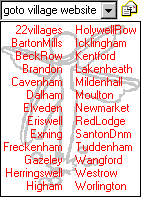





| |
Climate And Soil
Relief, Drainage And Soils
The river bed consists of hoggin sealed with clay that has been washed down
from other areas over the years. At about twenty feet down there is a layer of
chalk which reaches a depth of about 180ft . At about 200ft water can be found.
There are several reasons why the river is naturally dry during the summer,
excluding the water from the sewerage plant.
 | The water table has become
slightly lower, so limiting the amount of water flowing into the river |
 | The
water extracted by pumping, drains any small amount of water from the river
during the summer |
Moulton lies in a valley and at its base is cut by the river Kennett, which
eventually flows into the Lark and into the Wash. The hills that surround
Moulton rise to a height of 250ft. At the base of the valley near the river,
grazing land is possible for sheep, because of the well drained chalk soil.
Plantation Hill, which is behind the church, shows a topsoil of chalk, it stands
200ft above sea level. North of the valley the river bed was normally dry during
the summer, which is typical of the Kennett. The floor narrows and the sides
steepen. the steepness is especially marked on the Gazeley side of the river. On
the Newmarket side of the river is the large tributary valley which follows the
road from Moulton to Newmarket, along part of its way. It seems possible that
when the run off was greater, the water flowed down the tributary valley with
such force that it caused the Kennett to undercut on the opposite side, giving
steeper valley sides. Out of Moulton, the valley's side becomes more regular and
uniform. A cross-section of the bourne, shows that the gravel content is
increased slightly.
The soil in the parish falls into three main types:
 | Well drained course and fine loam soils, shallow calcareous course loam
over chalk or chalk rubble in places. Slight risk of water erosion. |
 | Deep non - calcarseous loam soils in places. |
 | Shallow well drained calcareous course loam and sandy soils over chalk
rubble. Slight risk of water erosion. |
Relief and Drainage, by Gordon Slack of Newmarket.
The Climate Of Moulton
As Moulton lies in a valley it is not subject to high winds. The climate is
moderate and allows cereals to be grown on the farms. As Moulton is fairly
small, it has no weather station of its own, but weather forecasts and
recordings can be gained from local weather stations, situated in both Newmarket
and at R.A.F.Mildenhall station. The following chapter refers to Suffolk climate
as a whole, but for the local climate it is advisable to consult the readings of
the weather stations to gain some idea of the climate and the annual rainfall.
Suffolk, owing to its geographical position, suffers from east winds in winter
and especially in the spring, and thus tends to be cold at these times of the
year. Occasional strong winds arise which blow for days together, (known locally
as 'the blows'). These in former days were broken by the numerous trees and
hedges scattered over the face of the county, which gave some protection from
the force of the gales. The wholesale removal of these natural windbreaks during
recent years, in the interest of agriculture, is to be deplored, for, with their
destruction not only has much of the picturesqueness of the countryside been
spoilt, but there has been a tendency for the higher parts of the country to
become bleak and unattractive, especially in the West. The local temperature is
conditioned by the county being bounded on the East by the sea, this tending to
lower it in summer and raise it in the winter, with the result that it is fairly
equable all the year round. As regards rainfall, Suffolk must be ranked on of
the driest counties, for its yearly average is only about 23 inches which is
much below that for the rest of the country (36 inches).
Month
|
Rainfall
|
Sunshine
|
| January |
1.99 inches |
52.6 hours |
| February |
1.41 inches |
69.9 hours |
| March |
1.45 inches |
118.8 hours |
| April |
1.20 inches |
167.1 hours |
| May |
1.65 inches |
209.6 hours |
| June |
1.90 inches |
210.2 hours |
| July |
2.50 inches |
189.5 hours |
| August |
2.15 inches |
181.9 hours |
| September |
1.99 inches |
136.6 hours |
| October |
1.93 inches |
108.1 hours |
| November |
2.13 inches |
58.8 hours |
| December |
1.74 inches |
43.5 hours |
The figures above were supplied by RAF Mildenhall in 1965:
Many people in the village speak of the winds that would continue for days on
end, they were called 'the blows'. Damage would be caused to crops, blowing
seeds away. In the winter of 1946/47 the village was cut off for several days by
large snow drifts.
|